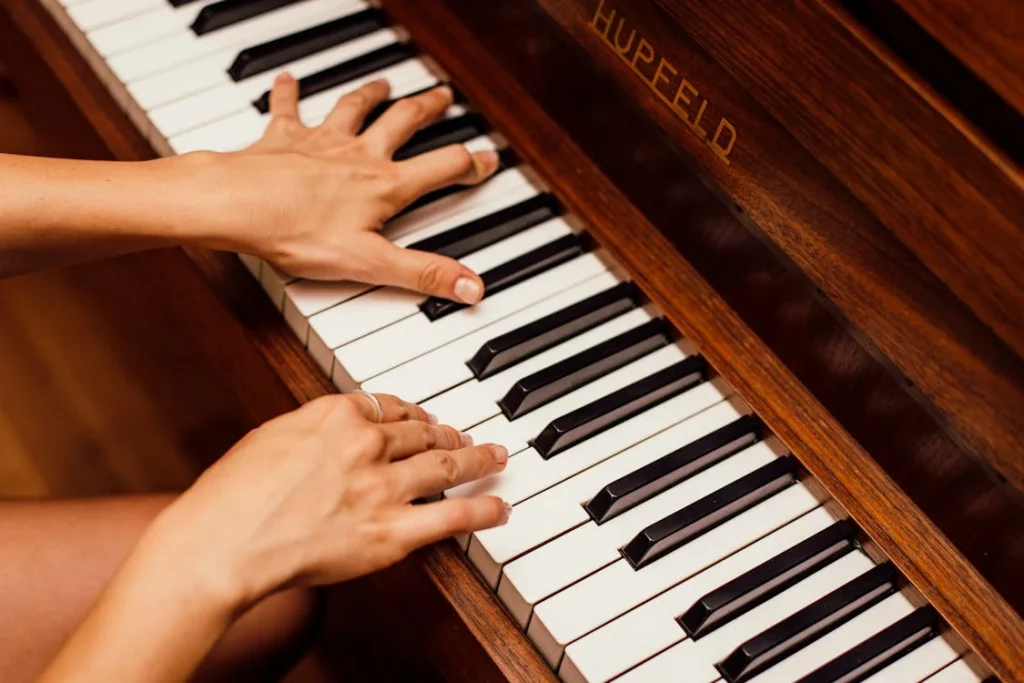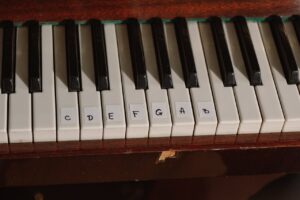Learning to understand music theory is a lot like learning a new language. Music theory has its own particular grammar and contextual idiosyncrasies. One important and often difficult aspect of music theory is learning about scales, particular major and minor scales.
Scales form an important building block of melodies, harmonies, and chord progressions. One of the most important facets of scales is the concept of relative major and relative minor. Composers use the concept of relative major and minor to seamlessly shift between related major and minor keys.
In this article, we will delve into relative major and minor scales, learn how to identify them, and investigate their significance in music composition and performance.
- Fall in love with the music - Learn your favorite songs, at a level suitable for you.
- Enjoy interactive piano lessons - Explore courses covering music theory, technique chords & more.
- Get real-time feedback - Skoove's feedback tells you what went well and what needs practice.

Understanding major and minor scales
First, let’s take a brief review of major and minor scales. Understanding the basics of scales is extremely helpful when learning how to play piano.
Structure of major scales
A major scale is a diatonic scale consisting of seven notes, with a specific pattern of whole steps (W) and half steps (H). The pattern for a major scale is: W-W-H-W-W-W-H. This pattern of intervals gives the major scale a bright and happy sound.
For instance, the C major scale consists of the notes C, D, E, F, G, A, and B. If you play these notes on a piano, starting from C and ending on the next C, you’ll hear a familiar, uplifting sound.
Structure of minor scales
Minor scales, on the other hand, have a more somber or melancholic sound. There are three types of minor scales: natural minor, harmonic minor, and melodic minor. We will primarily work with the natural minor scale. The natural minor scale follows the pattern: W-H-W-W-H-W-W.
For example, the A natural minor scale consists of the notes A, B, C, D, E, F, and G. You will find that this scale consists of all the white keys on the piano, from A to A, just as the C major scale consists of all the white keys on the piano from C to C. This is the crux of the relative major/minor relationship.
Key differences between major and minor scales
The primary difference between major and minor piano scales lies in their third note. In a major scale, the interval from the root to the third note is a major third (four half steps), whereas in a minor scale, this interval is a minor third (three half steps).
This small change has a significant impact on the overall mood of the scale. Additionally, the pattern of whole and half steps in each scale creates different emotional responses and is used to convey various musical ideas.
Furthermore, the scale degrees between the relative major and minor scales differ, as the root note of the scale changes.
Understanding relative scales
Relative major and minor scales are pairs of scales that share the same key signature but start on different root notes. The relative minor of any major scale starts on the sixth degree of that major scale, while the relative major of a minor scale starts on the third degree of that minor scale.
Despite their different starting points, these pairs contain the same notes, making them “relative” to each other.
For example, the C major scale (C, D, E, F, G, A, B) and the A minor scale (A, B, C, D, E, F, G) have no sharps or flats in their key signature. This means they contain the same pitches, but their tonic notes (the notes they start and end on) differ.
This relationship allows composers and performers to shift between major and minor modes seamlessly, providing a versatile tool for musical expression.
Identifying relative major and minor scales
Now let’s practice identifying relative major and minor scales.
How to find the relative minor scales of major scales
Finding the relative minor of any major scale is straightforward. All you need to do is start on the sixth note of the major scale.
For example, in the C major scale (C, D, E, F, G, A, B), the sixth note is A. Therefore, A minor is the relative minor of C major. Both scales share the same notes and key signature (no sharps or flats).
In the key of G major, the sixth note is E. This means that E minor is the relative minor of G major. Simple, right?
How to find the relative major scales of minor scales
To find the relative major of a minor scale, start on the third note of the minor scale. For example, in the A minor scale (A, B, C, D, E, F, G), the third note is C. Therefore, C major is the relative major of A minor. Again, both scales share the same notes and key signature.
Let’s look at some more examples:
- The G major scale (G, A, B, C, D, E, F♯) has E minor (E, F♯, G, A, B, C, D) as its relative minor.
- The D major scale (D, E, F♯, G, A, B, C♯) has B minor (B, C♯, D, E, F♯, G, A) as its relative minor.
- The F major scale (F, G, A, B♭, C, D, E) has D minor (D, E, F, G, A, B♭, C) as its relative minor.
In this YouTube video, Joel Dave explains how to find relative minor scales using major scales and vice versa. He starts by demonstrating with the C major scale, where the relative minor is found by identifying the sixth degree of the major scale, which is A minor. He then repeats the process with the G major scale, finding that its relative minor is E minor.
Joel also explains how to find relative major scales from minor scales. Using the A minor scale, he shows that the relative major is located at the third degree, which is C major. He follows this with an example of the E minor scale, identifying G major as its relative major.
Throughout the video, Joel emphasizes numbering the scale degrees to easily locate the relative major or minor.
Musical theory behind relative scales
Let’s explore how musical theory explains the concept of relative scales.
The circle of fifths and its role in identifying relative scales
The circle of fifths is a visual representation of the relationships among the twelve tones of the chromatic scale, their corresponding key signatures, and their relative major and minor scales.
Each step clockwise on the circle represents a move up a fifth, while each step counterclockwise represents a move down a fifth. Relative major and minor pairs are found adjacent to each other on this circle.
For instance, C major and A minor are both found in the same segment, indicating their shared key signature.
Insert image of Circle of Fifths
Relative major and minor scales in composition
In music composition, relative major and minor scales provide composers with a versatile palette of sounds. By shifting between relative major and minor, composers can create contrast, tension, and resolution within a piece. This technique is evident in many classical compositions, as well as in contemporary music genres.
For instance, a song might start in a major key to convey a joyful mood, then transition to its relative minor for a more introspective or melancholic section before returning to the major key for resolution.
Exercises for identifying and playing relative major and minor scales
Here are some key practical exercises to follow:
- Identification drill: Write down the notes of a major scale and identify its relative minor by locating the sixth note. Repeat this for all major scales.
- Playing scales: On your instrument, play a major scale followed by its relative minor. Notice the shared notes and differing starting points. This is a great practice for remembering the piano notes.
- Transposition practice: Choose a piece of music in a major key and transpose it to its relative minor. Observe how the mood changes.
One popular method is to count down a minor third (three semitones) from the major root note, a technique commonly used by music students.
Another approach emphasizes the importance of learning key signatures. Understanding the order of sharps and flats and their application to major and minor scales can significantly enhance one’s musicianship. Writing out scales and key signatures on manuscript paper, starting from C in the circle of fifths and F in the circle of fourths, is beneficial.
Another effective tool is the Circle of Fifths. You can find the relative minor of any major key by moving clockwise three notches from the major key. You can find the relative major of any minor key by moving counterclockwise three notches from the minor key. This visual aid provides a clear and efficient way to understand the relationship between major and minor scales.
Common misconceptions and mistakes
One common mistake is confusing relative scales with parallel scales. Relative scales share the same key signature but start on different notes, while parallel scales start on the same note but have different key signatures. For example, C major and C minor are parallel scales because they start on the same root note. C major and A minor are relative scales because they share the same exact set of pitches, much like the musical modes.
Another pitfall is not fully internalizing the interval patterns of scales, which can lead to errors in identifying relative scales.
To avoid confusion, remember that relative scales are connected by their shared key signatures, not their starting notes. Practicing scales and using visual aids like the circle of fifths can help reinforce this distinction.
Practical exercises with Skoove
Skoove is an excellent resource for learning and practicing piano scales, including relative major and minor scales. The platform offers interactive lessons that guide you through the process of identifying and playing these scales and their accompanying piano chords.
With Skoove, you can practice scales at your own pace, receive instant feedback, and improve your musical skills efficiently.
It’s all relative
Learning to master relative major and minor scales is an important step for any musician interested in a deeper understanding of music theory. These scales offer musicians a framework for shifting moods and emotions within the same set of notes.
By incorporating relative major and minor scales into your practice, you can expand your fluency with the tools of music theory, uncover new and interesting sounds and emotional possibilities, and gain technical flexibility on the piano.
For those keen on mastering these concepts, Skoove provides an invaluable tool. It offers structured lessons and practical exercises that make learning piano scales accessible and enjoyable.
Whether you are a beginner or an experienced musician, exploring relative scales will undoubtedly enrich your musical journey!
Author of this blog post:
Susana Pérez Posada

With over seven years of piano education and a deep passion for music therapy, Susana brings a unique blend of expertise to Skoove. A graduate in Music Therapy from SRH Hochschule Heidelberg and an experienced classical pianist from Universidad EAFIT, she infuses her teaching with a holistic approach that transcends traditional piano lessons. Susana’s writings for Skoove combine her rich musical knowledge with engaging storytelling, enriching the learning experience for pianists of all levels. Away from the piano, she loves exploring new places and immersing herself in a good book, believing these diverse experiences enhance her creative teaching style.
Published by Lydia Hovan from the Skoove team















